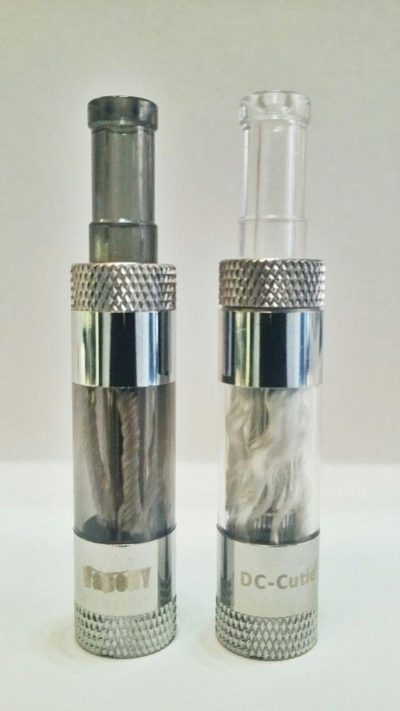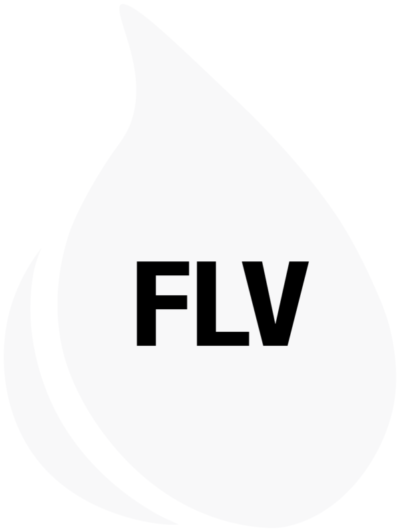
“Smoker! We’ve got a smoker over here!”
A middle-aged man in a denim baseball hat and black faux-leather jacket stands frozen at the room’s double-door entrance, visibly aware of our eyes on him. He pulls a fresh pack of Marlboro Lights from his pants pocket.
Standing across a cluttered folding table from the man, Spike Babaian, president of the National Vapers Club, pulls the mic away from her mouth and points to the blood-red carpet. After a pause, the man drops his pack on the ground.
“Stomp it! Stomp it!” screams Babaian into the mic. Her long, goth-black hair bounces into a mess, accentuating her enthusiasm. The man erupts, bashing his foot onto the pack. “Harder!” The scene looks like something out of American History X. “It’s dead! Woooohooo!! Nice!” says Babaian. “We have a new vaper in the house.”
This is Vapefest, founded by Babaian and one of a growing number of large meetups happening around the country, devoted entirely to e-cigarettes and the life that goes with them.
At the edges of a Best Western catering room in Rockville Center, Long Island, groups of vapers mill about, examining e-cig paraphernalia displayed at a few dozen vendor booths. Young guys sit around tables sucking on what look to the untrained eye like fancy metal dildos from the future. Everyone is blowing clouds of odorless white vapor into the air. All I smell is the $10-a-plate buffet.
Maybe you’ve read a news story about e-cigarettes, seen them for sale, or bumped into someone conspicuously vaping away at your favorite bar. But the e-cigarettes available at your local gas station or drug store are just the tip of an iceberg. The scene runs deep and wide and is home to a fiercely passionate subculture of people who combine fanboy zeal with the righteousness of the converted while spawning an underground economy around the surprisingly controversial claim that it can help smokers quit. Thanks to definitions the government disputes and regulation lurking around the corner, it’s a subculture at real risk of vanishing in a cloud of vapor.
Every e-cigarette has four basic components: a battery, which makes up the bulk of the device; a heating mechanism called an atomizer; a container, known by a variety of names depending on the design – cartomizers, clearomizers, tanks – which often houses the atomizer and holds what’s known as “e-juice” or simply “juice” or “liquid;” and the e-juice itself – the stuff that makes the vapor – which contains propylene glycol (PG) and vegetable glycerin (VG), food flavoring and, most often, nicotine.
Thanks to definitions the government disputes and regulation lurking around the corner, it’s a subculture at real risk of vanishing in a cloud of vapor.
The individually wrapped e-cigarettes you’ll find at a gas station all have these parts, though you wouldn’t know it by looking at them. These products, made popular by brands like Blu or NJoy, are generally designed to look like tobacco cigarettes. They are often disposable, meaning the battery cannot be recharged, and it’s often impossible to re-fill the e-juice once it runs out. In other words, they are complete pieces of crap.To get the good stuff, you need to go online, where you’ll find a whole universe of devices: Better, bigger batteries; countless different flavors of e-juice, from regular “tobacco” to “chocolate chip cookie,” all packaged in little clear squeeze bottles; an array of cartomizers, clearomizers (an improved version of a cartomizer), and a mystifying mess of other components.
Anyone worth his weight in e-juice uses what’s known as a personal vaporizer, also called a “PV” or a “mod.” More expensive than other e-cig devices, PV’s have replaceable batteries, and often pack microchips that allow you to change the power output. Cheap cartomizers are regularly replaced with tanks, which are much bigger and more heavy-duty than other options, and the atomizers are often re-buildable – pro-level vaping. The variation on all of these is virtually endless, allowing for super-customization – and every single options is on display all around me at Vapefest.
Across the room, I spot Rich Gavina, a marketing professional by trade, and one of the most avid e-cigarette nerds I’ve had the pleasure of meeting. On the table in front of him lies a black metal carrying case filled with an assortment of PVs and mods. It looks like a robot sex toy collection – sleek chrome, ribbed for maximum vaping pleasure.
Gavina says he only started vaping about a year ago, but has already dropped in the neighborhood of $4,000 on e-cig equipment. He seems to know everyone, and has built an encyclopedic knowledge of the gear.
“The last thing you want to do when you’re a new vaper is to be ignorant,” says Gavina. “If you’re a casual vaper, that’s cool. If you want to be considered an enthusiast, you’ve got to know your stuff.”
While meets like Vapefest are becoming more abundant, the community lives and breeds on the Web. Gavina goes by TowerOfVape online, and has amassed more than 5,600 Twitter followers. He regularly takes part in Google Hangouts, a massively popular service among the vaping community. He also has a blog, a Facebook Page, and regularly hosts e-cigarette Web shows – all of which appear to be prerequisites for hardcore vaping enthusiasts.
Despite the fact that I have been vaping for about two years, an enthusiast I am not. I just don’t have the personality for superfandom. The e-cig gear I buy is basic: an eGo battery (one of the more popular “beginner” devices) and a cheap clearomizer. My setup looks dinky. To the pros of Vapefest, I look like an amateur.
Adam Daniels (a.k.a. “Most Angry Pirate,” or just “MAP”) sits next to Gavina, sipping on a bottle of beer. He has a shaved head, a worker’s build, and a look on his face that says he’s dealt with a lifetime of bullshitters. A former big rig truck driver, Daniels invented the first tank to hold more e-juice during his long hauls. Products that mimic his design are now some of the most sought-after components on the blossoming e-cig market. He notices my lame setup. “Obviously you’re a newb,” he says with something like a smile. “You’re vaping an eGo at the biggest trade show in the country.”
Daniels first got into vaping back in 2005, long before almost anyone, before the blossoming e-cig startup industry on display all around us existed. Back then, he says, they would do anything to improve upon the low-quality e-cigs being imported from China. So they started creating their own.
“We used to all make mods out of flashlights,” he says. “We used to all go to Home Depot and Harbor Freight, and break flashlights to make shit similar to this [mod], so we could vape. That’s the truth. As stupid as it sounds, that’s how we started.”
It is Daniels’ DIY spirit that permeates the entire industry. New online vendors appear on the Web every week. Some sell components imported from overseas. Many create their own custom e-juices. Everyone, it seems, is an entrepreneur. But that doesn’t mean they’re only in it for the money; many of them just want to get in as deep as they can.
I bump into an affable 20-something guy who introduces himself as “Gothic Vash,” his name on the e-cig forums. “Or Tyler,” he says. He’s wearing a camo-green military jacket, the kind with an infinite number of pockets. But it’s his blond handlebar mustache and 8-inch tall blue Mohawk that I notice first.
“I don’t like buying mass produced stuff,” he says. “I like buying something that somebody built. That way it’s not like the money’s going somewhere else. It’s staying in the community and we’re all supporting each other. I think that just makes it a strong, closer-knit kind of thing.”
Tyler makes and sells his own tanks, but only enough to support his e-cig habit, he says, which clearly has quite the grip. He pulls from his pockets three different mods, all custom made, each costing more than $100 apiece. In his right hand is the most outrageous mod I’ve ever seen: a kinky, two-foot long brass contraption designed with straight steampunk aesthetic. It’s one-of-a-kind, and he refuses to reveal its cost.
“People think it’s a crack pipe or a bong,” he says. “People who smoke are like, ‘What the hell are you doing?’ And I’m like, ‘It’s an e-cig.’”
Of course, says Tyler, this answer only gets people to ask more questions. And that’s okay by him. Maybe the conversation starter will lead to someone switching from smoking to vaping – the valiant vaper crusade.
“That’s one of the reasons I’m not shy about it at all; because people who smoke might not have seen it before,” says Tyler. “And if you’re out in public doing it, and what you’re doing is obviously not smoking, they’re going to ask questions, and maybe you can help them too. That’s really the bottom line: We just want everybody doing it. It’s not killing yourself anymore.”
This mission to convert every smoker to vaping is something I hear endlessly at Vapefest. You see it on devoted online communities, like Reddit’s r/electronic_cigarette community, and E-Cigarette Forum (ECF), the master hive of vaping. But it’s not just senseless pushing: Almost all vapers smoked – and now they don’t. They see the benefits – no tar, far fewer chemicals, no smoke, no smell – and they want to share their death-defying trick with those who are still turning their lungs black.
Based on my own experience and more than a hundred other vapers’ stories I heard, if you give vaping an honest try, there’s a good chance you’ll never smoke another “analog” cigarette ever again.
“You’re not downgrading from a cigarette. You’re getting something more,” says Chris Mikovits, who co-owns e-cig retailer CherryVape with his business partner, Cheryl Richter. Well known in the world of vaping, Mikovitz used his skills as a carpenter to create the most copied “drip tip” – the piece you put your lips on when vaping an e-cig – on the market.
“You’re getting accessories, you’re getting colors, you’re getting flavors. You’re able to tune the experience – fine-tune it to you.”
The sensation of vaping is not identical to smoking. The closest comparison may be puffing on a hookah – lighter, less over-powering than analogs. But the experience heavily depends on your setup – which battery you use, the voltage setting, the tank or cartomizer model and, of course, the flavor and PG-to-VG mix of your e-juice. Find the right setup, vapers say, and you’ll never miss your Marlboros.
Legally speaking, the “quit smoking” terminology is only available to pharmaceutical companies that produce nicotine patches and gum, or drugs like Chantix. E-cigarettes are, according to the courts, considered a tobacco product under federal law.
“The one thing we’re not allowed to say, as vendors, is ‘quitting,’” says Mikovits, as he takes a pull on a posh chromed-out PV with a tie-dye drip tip. “We can’t say ‘quitting’ because of the fact that we’re making a ‘health claim.’ So we say ‘switching.’ ‘I stopped burning tobacco in 2009′ is the safest way for me to say it.”
The reason for all this linguistic maneuvering stems from a 2009 federal court decision, which overturned the U.S. Food and Drug Administration’s classification of e-cigarettes as a “drug delivery” mechanism – a pharmaceutical. Had the FDA gotten its way, the agency would have put the kibosh on e-cigarettes in the U.S. for at least 10 years, while the FDA conducted studies. There would be no Vapefest, no bustling startup industry – and, the theory goes, a hell of a lot more smokers.
Despite what the rules say, e-cigarette users have zero doubt that the devices helped them quit puffing down smoke.
“With vaping, you’re replacing a pleasurable habit with another pleasurable habit, one that people find even more pleasurable than smoking.”
Russ Wishtart, a high-end stereo equipment salesman who runs a monthly vape meetup in Manhattan and hosts the popular weekly vaping podcast ClickBang!, says he “never had an intention to quit smoking” – he “just didn’t want to smell like smoke” anymore. He tried the patch and the gum, but neither worked. Then he discovered e-cigs.
“With vaping, you’re replacing a pleasurable habit with another pleasurable habit, one that people find even more pleasurable than smoking,” says Wishtart. As such, e-cigarettes are a far more effective way to ditch analogs, he says.
The science – what relatively little there is, so far – at least partially agrees with Wishtart’s sentiments. A 2010 study published in the journal Addiction found that smokers use e-cigarettes “much as people would use nicotine replacement medications.” The study concluded by saying that more research was needed to ascertain “the safety and efficacy of e-cigarettes for administration of nicotine and other substances, and for quitting and relapse prevention.”
The Addiction study was followed in 2011 by one published in the American Journal of Preventative Medicine (PDF), which found that “e-cigarettes may hold promise as a smoking-cessation method and that they are worthy of further study using more-rigorous research designs.”
We could sift through the full gamut of studies here, but the end result would be the same: the sheer inconclusiveness of most e-cig health studies renders them dissatisfying. So we’re left with millions of people who are using e-cigarettes to quit smoking. And that might be a great thing – or it might cause brain cancer. We just don’t know.
Vapers view the choice in simple terms: Keep smoking or try something new. We know cigarettes kill millions thanks to the hundreds of toxic chemicals they contain. E-juice, by contrast, only has four ingredients, the primary of which – PG and VG – have been approved for human consumption, and have never been found to cause cancer or anything else. In fact, both are used in food. PG, it should be noted, is also used in “non-toxic” antifreeze, as a safer substitute for highly toxic ethylene glycol – so it would be incorrect to call PG itself antifreeze. Nicotine, for its part, is not considered to be the primary cause of cancer in analog cigarettes – it’s just what keeps people hooked. And, judging by the scene around me, vapers are clearly hooked.
A few hours into Vapefest, I sit down with Xavier Armand, vice president of marketing for Bloog e-cigarettes. Armand looks like every nice, cool guy you ever met in college – in fact, he was studying for his PhD in chemistry before he quit to get into the e-cig biz full time. I ask for his take on the e-cig health debate, as he puffs away on one of Bloog’s newest models, a thin and elegant device.
“To me it’s about recognizing the knowns versus the unknowns,” says Armand. “I don’t know what inhaling PG and VG is going to do. And I don’t want to say that it’s going to be perfect; there may be some side effects.” But he does know that analogs will kill him.
‘I can breath better. I can run more. I feel better. My lungs feel better. My teeth are no longer yellow.’
“E-cigarettes have been around for more than five years, and you have a whole mess of people who have been using who swear by, ‘I can breath better. I can run more. I feel better. My lungs feel better. My teeth are no longer yellow,’” he adds. “And if we combine what we know scientifically with the consumers’ experience, you can kind of come away and say, ‘Well, it’s going to be safer than a cigarette.’”Armand isn’t kidding about the mess of people or the benefits they swear by. After I asked redditors to get involved with this story, the community’s floodgate burst with stories about how e-cigarettes affected their lives. Some say they lost weight, others told of praise from their doctors. Countless people had an e-cig business, from review sites and magazines to e-stores and dedicated brick-and-mortar shops. All of them told me how e-cigs helped them quit smoking when nothing else could.
While vapers remain adamant that e-cigarettes provide a near-perfect alternative to smoking, the FDA continues to threaten to fight back with greater regulation.
“FDA intends to propose a regulation that would extend the agency’s ‘tobacco product’ authorities – which currently only apply to cigarettes, cigarette tobacco, roll-your-own tobacco, and smokeless tobacco – to other categories of tobacco products that meet the statutory definition of ‘tobacco product,’” an FDA spokesperson told me.
The FDA said it would issue its proposed e-cigarette regulations in April – but that threat never came true, just as it hasn’t come true in the past. Still, many in the industry fear an all out ban and what it would do for their lives.
“This is a world that regulation would cripple,” says Greg Conley, legislative director for the Consumer Advocates for Smoke-free Alternatives Association (CASAA), a grassroots, volunteer-based political activism group for users of e-cigs and other smokeless alternatives to tobacco cigarettes. “This is a world of technology, unlike tobacco. This is a world where, every two weeks, there’s a new product on the market for the people who want to spend a lot of their money on mods to buy.” And because of that, he says, requiring vendors to fill out mountains of paper work every time they release a new product would wreak havoc on the industry and the community it serves.
As much as vapers fear the FDA – virtually everyone at Vapefest mentions this menace – Conley says the constant impending doom is also what makes the vaping community so tight-knit.
“I think that sense of urgency about e-cigarettes that exists within more experienced users, that sense of urgency that exists about legislation, fosters the community,” says Conley. “Unlike a lot of consumer products that Digital Trends writes about – traditional consumer technology – there aren’t groups out there saying that your consumer technology is dangerous and unregulated, and made by people who have no regard for public health.”
The threat of greater government regulation has had another effect on the community, says Wishtart; those who become enthusiasts often develop a stark libertarian tinge.
“The reason [so many vapers are libertarian] is not because libertarians are getting into e-cigarettes, but e-cigarettes are making people libertarian,” he says. “… They see a government trying to take away a precious right.”
As the evening wears on, I sit down with Joe Petner, a burly New Jersey native who looks like a bouncer for a mob-owned strip club. A gold chain lanyard hangs around his neck, with a Ron Jeremy-sized mod dangling heavily at the end.
Petner runs VaporJoes.com, where he lists the best deals on e-cig gear. The site, which he says receives about a million visitors a month, is “just a hobby,” but one for which he has a passion. (His actual jobs include running an eBay store, as well as a list of porn sites – of course.) When I ask him whether he’s worried about what the FDA could do to the industry, he says he has a plan.
If “the big foot of the FDA” comes “crushing down” on e-cigs, says Petner, “then my site’s going to change into Vapor Joe’s Underground, and I’ll tell everybody where to get it.”
CherryVape’s Mikovits agrees; now that the vaping is in the ether of American life, there’s no reigning it back in.
“What [the FDA is] trying to do is make it go back to only technology that was available in 2007,” says Mikovits, “to the one’s that look like stick batteries. And get rid of all of this stuff, this really cool stuff, that works better and has actually helped people quit smoking.
“But how do you stop technology? You can’t. You can’t turn the clock back to 2007.”
Packing up to leave Vapefest, which will continue to roll on into the next night, I can’t help but feel a sense of sad anxiety for the e-cigarette community, as its neck lies waiting for the FDA guillotine. The people at Vapefest and throughout the e-cig world really do care about other people – it was clear in every interaction I had with this group. They want everyone to stop smoking, and believe in their hearts that e-cigarettes are the best way to do it. They are pushy and passionate evangelists for the technology they believe saved their lives. And maybe it has.
As I walk out the door, Babaian picks up the mic once again. “Smoker!” she says, pointing to a young woman who just walked past us in the opposite direction. “We’ve got a smoker over here!”
Stomp. Stomp. Stomp.
Correction: In an earlier version, CASAA was misidentified as a “lobbying group” for the “e-cigarette industry.” CASAA does not identify as such, and is instead entirely consumer-focused. This clarification has been updated in the copy.




















